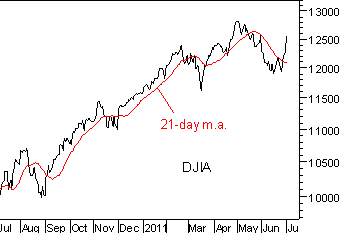It’s remarkable how consistently the market moves in seasonal patterns.
For example, it tends to make most of its gains in the winter months and experience most of its corrections in the summer months, as expressed in the old adage ‘Sell in May and Go Away’.
And just as it did last year, this year the market made good gains in the winter months, then topped out in late April, and was in a correction in May and most of June.
The shorter-term seasonal pattern is that the market is usually positive in the days surrounding the end of months, in what I have always called the ‘monthly strength period’, and particularly in the days approaching and surrounding the July 4th holiday. July also tends to be the most positive month in the market’s unfavorable summer season. Thus the tradition of a summer rally.
After being down eight of the previous nine weeks the market was short-term oversold going into this week. My technical indicators triggered a short-term buy signal and I’ve been predicting a brief short-term rally off the oversold condition, but also that the tendency for the market to be positive in the days surrounding the July 4th holiday, was likely to keep an oversold rally going into a sustained rally for awhile.
It’s uncanny how events usually work out with a timeliness that supports the seasonal patterns. The seemingly endless stream of dismal economic reports continued this week, but a couple of bright spots also showed up.
There was relief that the Greek Parliament passed the painful austerity measures required for Greece to receive additional bailout funds to prevent it from defaulting on its debt (or at least postpone its potential default). The rally got an additional boost from that.
And although economic reports included that construction spending fell again in May, that Consumer Confidence fell again in June (to a 7-month low), that weekly unemployment claims remained high at 428,000 last week, there was also the report that manufacturing activity, which has been declining for several months, unexpectedly picked up some in June, with the ISM Mfg Index rising to 55.3 from 53.5 in May. That gave the market another big boost on Friday.
The ‘monthly strength period’ is due to continue through Thursday of next week.
But it’s not just seasonality that says the rally is probably only a short-term summer rally, with the correction likely to resume to lower lows when the rally ends.
Technically, volume in the rally is very light, less than 0.8 billion shares traded daily on the NYSE, compared to as many as 1.6 billion on the down-days during the correction. That indicates that large institutional investors selling during the correction, are not believers in the sustainability of the rally and are not participating.
Also technically, the unusual spike-up of the last five days has the major indexes already short-term overbought above their 21-day moving averages, the opposite of their short-term oversold condition two weeks ago.

On the economic fundamentals, another bailout of Greece, and a one-month bump in the ISM Mfg Index are hardly an indication that the economic slowdown has ended, given the continuing dismal reports on consumer spending, consumer and business confidence, the depressed housing industry, and the jobs picture.
So enjoy the rally. It arrived on schedule.
But be careful about determining too quickly that it marks an important bottom or the end of the global economic problems.